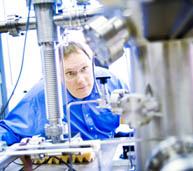The deeper meaning of wear and tear
The deeper meaning of wear and tear McGill University
User Tools (skip):
The deeper meaning of wear and tear

With the joints of the human body as his inspiration, Roland Bennewitz, an experimental nanomechanics professor, is researching friction at its most fundamental level.
CLAUDIO CALLIGARIS
Friction is inescapable. Whether it's braking to avoid an oncoming car or scraping one's knee, we all come across friction in one form or another.
The science of friction, called tribology, comes from the Greek tribos, meaning 'a rubbing.' The earliest vanguards of the field, the ancient Egyptians, overcame friction by using mud to facilitate the movement of stone blocks when constructing the pyramids. While we can all appreciate friction at this macroscopic scale, we are far less familiar with friction at its most fundamental, atomic level.
Friction between surfaces involves the forming, distorting and breaking of numerous contacts. Roland Bennewitz, a professor of experimental nanomechanics, investigates friction between individual atoms. He puts his work into perspective by pointing out that "of the billions of contacts between two sliding bodies, we study just one."
To take the measurements that his experiments require, Bennewitz and his students use a friction force microscope. The device's probe, basically a very sharp needle, is dragged along a specially prepared surface. "The needle is seen rattling from atom to atom, tat-a-tat, tat-a-tat tat-a-tat," Bennewitz said. With the microscope, researchers "poke, pull and squeeze atoms." They explore the interactions between atoms in the needle tip and those in the surface.
One of Bennewitz's findings is that friction between single atoms depends on their velocity. This is surprising because velocity does not affect friction at the macroscopic level. Although tribology is an old field and macroscopic friction has been thoroughly studied, "the classical laws of friction do not hold at the atomic scale" he said.
Bennewitz hopes to explore further the differences between friction at these two scales by using arrays of many needles. With the arrays, he will address whether groups of contacts behave differently from single contacts. The arrays will probe a few hundred contacts at a time and the results from these experiments may help us understand why friction involving billions of contacts is fundamentally different from atomic friction.
To study these effects at the atomic scale, Bennewitz and his student must design and then construct a friction force microscope that can work in the presence of a fluid lubricant. While at first the researchers were concerned only with interactions between the needle tip and surface, they will now look at forces between the tip, lubricant, and the surface. Bennewitz's inspiration for these experiments is the friction that occurs in human joints. "They're an excellent example of a perfectly lubricated system, at least for 80 years or so," said Bennewitz, "but how they actually work is not really well understood." In the long run, he hopes that the data produced from these experiments will be relevant to an understanding of friction in biological systems.
From the science of hip replacements to the future of nanotechnology itself, Bennewitz's work will undoubtedly influence how we see and deal with friction.
Khizr Rathore writes for WARM-SPARK (Writing About Research at McGill-Students Promoting Awareness of Research Knowledge), www.spark.mcgill.ca.

